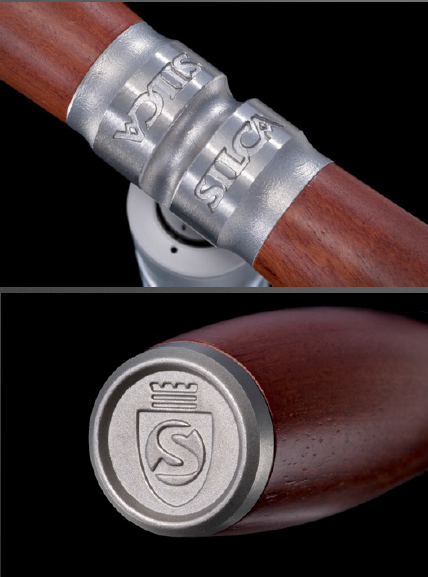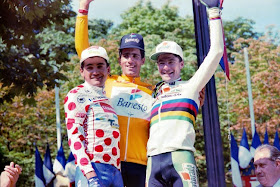Back when I was still basically a kid first discovering really nice bicycles, one of the first people I encountered who shared my passion was an older guy who rode a Mercian that he'd owned since the 1970s. He had the Professional model, with the long spearpoint bottom bracket shell and a classic barber pole paint job, deep red and white, built with the full Campagnolo Nuovo Record group. I don't even know how much time I must have spent admiring the details on that bike -- but I know it left an impression on me. Today I own eight of them.
 |
| The Mercian Shop, in Alvaston near Derby. |
Mercian have been building bicycles (that's British-style grammar -- not an error) since Tom Crowther and Lou Barker set up shop in Derby, England in 1946. Through the 50s and 60s, they gained quite a following with the British club riding scene. Their reputation for quality, beauty, and great-riding bikes continues right up to today. Mercian still make bikes today using the same time-honored, traditional techniques that they've used from the beginning -- building with Reynolds tubing, brazed together on an open hearth.
I was fortunate enough that Grant Mosley, who has owned Mercian since 2002 with his wife, Jane, was willing to take time out of his schedule to answer some questions for me about the company. Grant has been with Mercian for nearly 40 years. "I started as a Saturday lad," he says, "making cups of tea etc. in the shop. I was in the local cycling club and Jeff Bowler, the Shop Manager, asked me if I wanted a job while we were on a club run." I'm sure Grant never imagined at the time that he would one day own the place.
 |
| 1950's catalog, from the Mercian archives. |
Serious Mercian fans or collectors might be aware that co-founder Tom Crowther went on to also sell frames under his own name. Most of these were still built in the Mercian factory, though it's hard to know how many. "Records before 1970 were burned at a company Guy Fawkes bonfire party in the early '70s, so it's hard to know exactly," Mosley recalls. "I know Mercian built some Tom Crowther frames, as we still have stocks of transfers for them. Tom Crowther frames that we've resprayed have our frame number identity on them, but we don't know if all Tom Crowther frames were made by Mercian."
 |
| Use Google Maps to get an interactive view of the shop. You can use arrows to move around inside the shop. Very cool. |
 |
| Hand-shaping a Vincitore lug from a lug "blank" is a painstaking process. The results are exquisite. (photo from 2004 Mercian catalog) |
I asked Grant about the process of training the "new lads." He said, "Luckily we don't have to recruit new builders that often, but when we do they start with smaller jobs -- brazing dropouts and filing/finishing until they get the feel for the materials and tools. Then they start to build frames from start to finish, but with lots of supervision and assistance from a skilled builder." He then added, "Because Mercian build frames free-hand, without jigs, it takes longer to learn the art of framebuilding in this way."
 |
| Brazing free-hand in an open hearth. Few builders still use this traditional, time-honored method today. (photo from 2004 Mercian catalog) |
 |
| A view inside the Mercian frame shop. (photo courtesy of Bob Troy) |
Another tradition going back to the beginning is the almost exclusive use of Reynolds tubing. "We've always had a great relationship with Reynolds and because we've built with it from the start, the framebuilders have a real 'feel' for the tubing." Over the years, the company has built primarily with 531, and was among the earliest to be certified by Reynolds for 753. Today, Reynolds 631, 725, and 853 are popular choices. Grant says they have used other brands of tubing when customers have specifically asked them to, "but we still prefer Reynolds." The shop has also built some frames from 953 stainless, but supply interruptions have, at least for now, put that material on hold.
 |
| Long spearpoint lugs and a bold color palate distinguished the Paul Smith track bike. (from Mercian's site) |
 |
| Sir Paul Smith, on his stealth-black Mercian. (photo by Horst Friedrichs) |
Paul Smith also ordered a special "urban" fixed-gear bike for himself -- a "stealth" machine with a matte black finish and black components. Photos of Sir Paul with the bike have appeared in numerous non-cycling publications, including fashion magazines. Smith, a longtime cyclist who rode a Mercian in his teens and dreamed of becoming a professional bike racer (a bad crash ended that dream), frequently adorns his shop window displays with bikes -- a number of which were built by Mercian. Grant would not specify, but hinted that other collaborations may be in the works.
 |
| Ewan McGregor's Vincitore Special, with vintage Campagnolo parts. (photo from Derby Telegraph) |
More recently, Mercian built a bike for none other than Obi Wan Kenobi himself, actor Ewan McGregor. Grant told me how that came about. "I posted a picture of a leaf green Vincitore Special on our Twitter feed," he said. McGregor, who had been following the company's site, "saw the bike and said it reminded him of the first bike his dad bought for him." The actor contacted Mercian and placed an order for a Vincitore Special -- leaf green with a barber-pole paint scheme. He provided his measurements, and let Grant advise on the rest. McGregor spent some time searching eBay for vintage Campagnolo parts. "He supplied a few of the components to be fitted, like Campagnolo Delta brakes," added Grant.
 |
| Yes, that's my bike in the 2004 catalog. |
For those interested in ordering a new frame from Mercian, the wait time is currently about 5 - 6 months -- and that's true for celebrities, too. Even Ewan McGregor didn't get to jump the queue. When it comes to custom frames, the company offers some standardized specifications for racing, touring, track, audax, etc., which can be a good place to start, but customers have a lot of input on their frame order. Grant said, "We don't do trikes, triplets, 4-wheeled buggies, etc. but for solo frames we look at each enquiry as it comes and advise accordingly." I've found in my own experience that the company can be very accommodating for special requests, whether in colors, lugs, geometry, or whatever a person may desire for their dream bike. If one comes up with some ideas that the builders, in their experience, feel would not work well, they'll advise against it. Otherwise, a person can get pretty creative when ordering a Mercian.
 |
| The online frame builder lets you create your dream bike. Be careful -- it's addictive. |
Given that the company has been building frames for over six decades, there are a lot of vintage examples out there. Figuring out when a Mercian was built is usually pretty easy (but not always). On most vintage frames, the serial number will be located on the bottom bracket. Usually, the last two digits in the series will be the year that the frame was made. However, there have been some years, especially in earlier vintages like the 1950s, where the pattern was different and the first two digits were the build year. Sometimes, other details on the frame can provide clues, but according to Classic Lightweights UK, if a frame has a serial number like 59557, it may be impossible to know if it was built in 1959 or 1957. Also, I have seen some older Mercians -- notably some track bikes from the 50s -- where the serial number was stamped on the rear fork end instead of the bottom bracket. By the way, a second number stamped on the bottom bracket is a framebuilder's code, which can indicate who built the frame -- interesting to know. Since Y2K, the serial numbers have become unambiguous -- the year is now indicated with the full four digits -- xxx2013, for example.
I asked Grant if he's seen a resurgence of interest in Mercian frames. "We have a very full order book. The demand seems to be growing," he said. "There are a lot of riders out there who have never had a good steel frame. They started on alloy (aluminum), progressing to carbon, then trying the NEW steel frames." Not only that, he added, but the company also gets a lot of repeat business. "Most of our customers who order seem to re-order again and again once they have felt the difference in the ride quality." I know what he means. . .
My Mercians:
 |
| "Classic" model - 1979 -- my second Mercian. Reynolds 531. This one was refurbished at the factory in "Bianchi Blue" with a cream head-tube. |
 |
| 1973 Superlight - Reynolds 531 tubing. Original paint. Period-correct Campagnolo Nuovo Record group. When I found this, it was a nearly 40-yr-old new-old-stock frame. |
 |
| King of Mercia model. Reynolds 725. Modern Campagnolo Centaur group. |
 |
| 2012 Vincitore. Reynolds 631. Built as a "road/path" bike with a mix of old and new Campagnolo parts. Single speed, fixed gear. This one was pictured in the UK publication Urban Cyclist. |
 |
| 1980 Strada Speciale. The most recent addition to the collection. Built with a mix of age-appropriate parts, mostly of Japanese origin. Steep angles, fast handling, but a really nice ride. |
History and Tradition are such a big part of Mercian Cycles. And not just for the company itself -- but also for the people who ride the bikes. Like myself, who admired one in his youth and wanted so much to own one, there are many others who can tell similar stories. Look at Paul Smith, who raced on a Mercian in his teens, then decades later began designing bikes with the company. Or Ewan McGregor, drawn to a Mercian that reminded him so much of a bike his father bought him in his youth. Or even Grant Mosley -- working Saturdays at the shop as a lad, years later becoming the owner of the brand as it neared its 60th year in operation. I'll bet lots of people find themselves drawn to the bikes for similar reasons. And the brand is still there, still making bikes the way they did in the beginning, ready to welcome back old friends, or to greet new ones just discovering the virtues of a hand-crafted steel frame. The Mercian shop, its workers, the bikes, and the people who ride them are all part of this Tradition extending back to 1946.
Some Shop Photos (from a 2008 promotional calendar):
 |
| An assortment of tools on a framebuilder's workbench. |
 |
| A lugless fillet brazed frame. The joints are being smoothed to a seamless radius. |
 |
| A Paul Smith track frame, ready for paint. |
















.gif)















